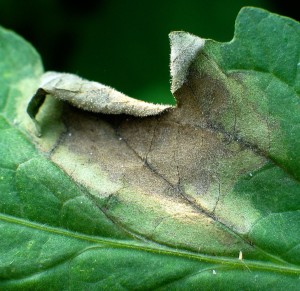
More basil downy mildew images.
It may feel like the Northeast gardening season is wrapping up. But your basil and tomatoes in particular need on-going vigilance because they are vulnerable to potentially devastating diseases, says Meg McGrath, plant pathologist at Cornell University’s Long Island Horticultural Research and Extension Center, Riverhead, N.Y.
Disease risk is increasing as the very hot, dry conditions of this summer shift to cooler, moister conditions with more frequent rain and long dew periods – all favorable for disease development, she explains.
Basil is at risk of attack from basil downy mildew, a new disease first seen in the U.S. in 2007 that has spread quickly in late summer each of the last two seasons in the Northeast. Sightings of this disease at the same time again this season suggests that, basil downy mildew is now a routine problem.
The first symptom that gardeners or growers are likely to spot is a slight yellowing on the upper surface of the leaves. Turning affected leaves over will reveal a grayish-purple (sometimes almost black) dusty growth which is the pathogen’s spores. Removing individual affected leaves won’t stop the disease, since the spores are easily moved on air currents.
McGrath suggests dropping everything when you first discover the disease on your plants, harvesting healthy-looking leaves, and preserving them as you usually would (by drying, freezing, making pesto, etc.) so you will have basil to enjoy later.
- View basil downy mildew images.
- Report outbreaks to help document disease occurrence and impact.
- NPR All Things Considered story: Basil Blight Threatens Pesto Lovers
- NPR Science Friday story: Spotting Summer Sickness In The Garden
- American Vegetable Grower story: Downy Mildew Wars

While late blight symptoms are distinctive – dark brown lesions on stems and leaves with white fungal-like growth developing under moist conditions – it’s possible to confuse it with other diseases. See Late blight ‘imitators’ to help distinguish late blight from other diseases. Your local Cooperative Extension office can help you with identification.
For steps you can take to avoid late blight and what to do if your tomatoes get it, see Avoid the late blight blues. (Because the disease is so contagious, it’s often better to be safe than sorry and remove and properly dispose of plants suspected to be infected.)


